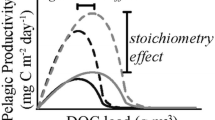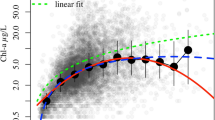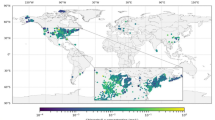Abstract
Primary production in freshwater ecosystems is largely a function of light and nutrient availability, both of which have been changing in many lakes and reservoirs in response to anthropogenic pressures. Recent studies focusing on natural lakes have found a hump-shaped response of primary production (sometimes measured as chlorophyll-a) to dissolved organic matter (DOM, measured as dissolved organic carbon, DOC), which has both light-absorbing chromophoric properties and DOM-bound nutrients. We used the United States National Lakes Assessment dataset to integrate reservoirs into this paradigm in comparison with natural lakes and assessed the relative differences in the predicted response’s model structure, regression parameter values, and drivers of the chlorophyll-a residuals. We found that chlorophyll-a in reservoirs exhibited a hump-shaped response to DOC, while natural lakes from this dataset were better fit with a linear response, differing from previous studies focused on boreal lakes. Despite this, reservoirs had a greater maximum chlorophyll-a response compared to natural lakes in this study (45.5 versus 33.8 μg L−1), which occurred at a lower DOC concentration threshold (18.3 versus 26.4 mg L−1) when compared using quadratic models. Reservoirs had lower median light:nutrient values compared to natural lakes, and greater median surface area and total phosphorus (TP), that can all influence the light environment and the peak chlorophyll-a responses. In both reservoirs and natural lakes, chlorophyll-a residuals were most strongly influenced by TP, where TP < 25–30 µg L−1 suppressed chlorophyll-a residuals and higher TP amplified them. Light:nutrient values were somewhat important predictors, and patterns with chlorophyll-a residuals supported previous work showing low light:nutrient values amplified chlorophyll-a responses and higher values suppressed them. Quantifying the shape of the response of primary production to DOM quantity and quality as well as the drivers of the residuals, namely TP for lakes and reservoirs in this dataset, will be important for understanding the effects that changes in water quality may have on primary production and freshwater ecosystem processes.





Similar content being viewed by others
Data availability
All data used in this analysis are publicly available from the U.S. Environmental Protection Agency (https://www.epa.gov/national-aquatic-resource-surveys/data-national-aquatic-resource-surveys).
References
Attali, D., & Baker, C. 2022. ggExtra: Add Marginal Histograms to 'ggplot2', and More 'ggplot2' Enhancements. R package version 0.10.0, https://CRAN.R-project.org/package=ggExtra.
Auret L, Aldrich C. 2012. Interpretation of nonlinear relationships between process variables by use of random forests. Minerals Engineering 35:27–42.
Beaulieu JJ, DelSontro T, Downing JA. 2019. Eutrophication will increase methane emissions from lakes and impoundments during the 21st century. Nature Communications 10(1):1–5.
Becker, O., Minka, A., & Deckmyn, A. 2021. maps: Draw Geographical Maps. R package version 3.4.0, https://CRAN.R-project.org/package=maps.
Bergström AK, Karlsson J. 2019. Light and nutrient control phytoplankton biomass responses to global change in northern lakes. Global Change Biology 25(6):2021–2029.
Carpenter SR, Kitchell JF. 1984. Plankton Community Structure and Limnetic Primary Production. The American Naturalist 124(2):159–172.
Cuthbert ID, del Giorgio P. 1992. Toward a standard method of measuring color in freshwater. Limnology and Oceanography 37(6):1319–1326.
DelSontro T, Beaulieu JJ, Downing JA. 2018. Greenhouse gas emissions from lakes and impoundments: upscaling in the face of global change. Limnology and Oceanography Letters 3:64–75.
Dormann CF, Elith J, Bacher S, Buchmann C, Carl G, Carré G, Marquéz JRG, Gruber B, Lafourcade B, Leitão PJ, Münkemüller T, McClean C, Osborne PE, Reineking B, Schröder B, Skidmore AK, Zurell D, Lautenbach S. 2013. Collinearity: a review of methods to deal with it and a simulation study evaluating their performance. Ecography 36:27–46.
Doubek JP, Carey CC. 2017. Catchment, morphometric, and water quality characteristics differ between reservoirs and naturally formed lakes on a latitudinal gradient in the conterminous United States. Inland Waters 7(2):171–180.
Downing JA, Cole JJ, Middelburg JJ, Striegl RG, Duarte CM, Kortelainen P, Prairie YT, Laube KA. 2008. Sediment organic carbon burial in agriculturally eutrophic impoundments over the last century. Global Biogeochemical Cycles 22:1–10.
Evans CD, Monteith DT, Cooper DM. 2005. Long-term increases in surface water dissolved organic carbon: Observations, possible causes and environmental impacts. Environmental Pollution 137:55–71.
Evans CD, Chapman PJ, Clark JM, Monteith DT, Cresser MS. 2006. Alternative explanations for rising dissolved organic carbon export from organic soils. Global Change Biology 12:2044–2053.
Fee EJ, Hecky RE, Kasian SEM, Cruikshank DR. 1996. Effects of lake size, water clarity, and climatic variability on mixing depths in Canadian Shield lakes. Limnology and Oceanography 41(5):912–920.
Fergus CE, Finley AO, Soranno PA, Wagner T. 2016. Spatial Variation in Nutrient and Water Color Effects on Lake Chlorophyll at Macroscales. PLoS One 11(10):1–20.
Greenwell BM. 2017. pdp: An R Package for Constructing Partial Dependence Plots. The R Journal 9:421–436.
Hanson PC, Bade DL, Carpenter SR, Kratz TK. 2003. Lake metabolism: Relationships with dissolved organic carbon and phosphorus. Limnology and Oceanography 48(3):1112–1119.
Isles PDF, Creed IF, Jonsson A, Bergström A-K. 2021. Trade-offs Between Light and Nutrient Availability Across Gradients of Dissolved Organic Carbon Lead to Spatially and Temporally Variable Responses of Lake Phytoplankton Biomass to Browning. Ecosystems 27:1837–1852.
Jaffé R, McKnight D, Maie N, Cory R, McDowell WH, Campbell JL. 2008. Spatial and temporal variations in DOM composition in ecosystems: The importance of long-term monitoring of optical properties. Journal of Geophysical Research: Biogeosciences 113:1–15.
Kelly PT, Solomon CT, Zwart JA, Jones SE. 2018. A Framework for Understanding Variation in Pelagic Gross Primary Production of Lake Ecosystems. Ecosystems 21(7):1364–1376.
Knoll LB, Vanni MJ, Renwick WH. 2003. Phytoplankton primary production and photosynthetic parameters in reservoirs along a gradient of watershed land use. Limnology and Oceanography 48(2):608–617.
Kothawala DN, Ji X, Laudon H, Ågren AM, Futter MN, Köhler SJ, Tranvik LJ. 2015. The relative influence of land cover, hydrology, and in-stream processing on the composition of dissolved organic matter in boreal streams. Journal of Geophysical Research: Biogeosciences 120:1491–1505.
Kritzberg ES, Ekström SM. 2012. Increasing iron concentrations in surface waters—a factor behind brownification? Biogeosciences 9:1465–1478.
Kutner MH, Nachtsheim CJ, Neter J. 2004. Applied Linear Regression Models, 4th edn. McGraw Hill.
Leach TH, Beisner BE, Carey CC, Pernica P, Rose KC, Huot Y, Brentrup JA, Domaizon I, Grossart H-P, Ibelings BW, Jacquet S, Kelly PT, Rusak JA, Stockwell JD, Straile D, Verburg P. 2018. Patterns and drivers of deep chlorophyll maxima structure in 100 lakes: The relative importance of light and thermal stratification. Limnology and Oceanography 63(2):628–646.
Leech DM, Pollard AI, Labou SG, Hampton SE. 2018. Fewer blue lakes and more murky lakes across the continental U.S.: Implications for planktonic food webs. Limnology and Oceanography 63(6):2661–2680.
Liaw A, Wiener M. 2002. Classification and Regressiong by randomForest. R News 2:18–22.
Monteith DT, Stoddard JL, Evans CD, de Wit HA, Forsius M, Høgåsen T, Wilander A, Skjelkvåle BL, Jeffries DS, Vuorenmaa J, Keller B, Kopácek J, Vesely J. 2007. Dissolved organic carbon trends resulting from changes in atmospheric deposition chemistry. Nature 450:537–540.
Morris DP, Zagarese H, Williamson CE, Balseiro EG, Hargreaves BR, Modenutti BE, Moeller RE, Queimalinos C. 1995. The attenuation of solar UV radiation in lakes and the role of dissolved organic carbon. Limnology and Oceanography 40:1381–1391.
Nürnberg GK, Shaw M. 1999. Productivity of clear and humic lakes: nutrients, phytoplankton, bacteria. Hydrobiologia 382:97–112.
Oliver SK, Collins SM, Soranno PA, Wagner T, Stanley EH, Jones JR, Stow CA, Lottig NR. 2017. Unexpected stasis in a changing world: Lake nutrient and chlorophyll trends since 1990. Glob Chang Biol 23(12):5455–5467.
Olson CR, Solomon CT, Jones SE. 2020. Shifting limitation of primary production: experimental support for a new model in lake ecosystems. Ecology Letters 23(12):1800–1808.
Omernik JM. 1987. Ecoregions of the Conterminous United States. Annals of the Association of American Geographers 77(1):118–125.
Pilla, R. M., Williamson, C. E., Adamovich, B. V., Adrian, R., Anneville, O., Chandra, S., Colom-Montero, W., Devlin, S. P., Dix, M. A., Dokulil, M. T., Gaiser, E. E., Girdner, S. F., Hambright, K. D., Hamilton, D. P., Havens, K., Hessen, D. O., Higgins, S. N., Huttula, T. H., Huuskonen, H., . . . Zadereev, E. 2020. Deeper waters are changing less consistently than surface waters in a global analysis of 102 lakes. Scientific Reports 10(1): 1–15.
Puts IC, Ask J, Deininger A, Jonsson A, Karlsson J, Bergström AK. 2022. Browning affects pelagic productivity in northern lakes by surface water warming and carbon fertilization. Global Change Biology 29:375–390.
R Core Team. 2022. R: A language and environment for statistical computing. R Foundation for Statistical Computing, Vienna, Austria. https://www.R-project.org/.
Read JS, Rose KC. 2013. Physical responses of small temperate lakes to variation in dissolved organic carbon concentrations. Limnology and Oceanography 58(3):921–931.
Roulet N, Moore TR. 2006. Browning the waters. Nature 444:283–293.
Seekell DA, Lapierre J-F, Ask J, Bergström A-K, Deininger A, Rodríguez P, Karlsson J. 2015. The influence of dissolved organic carbon on primary production in northern lakes. Limnology and Oceanography 60:1276–1285.
Smith VH. 1979. Nutrient dependence of primary productivity in lakes. Limnology and Oceanography 24(6):1051–1064.
Smith SV, Renwick WH, Bartley JD, Buddemeier RW. 2002. Distribution and significance of small, artificial water bodies across the United States landscape. Science of the Total Environment 299:21–36.
Solomon CT, Jones SE, Weidel BC, Buffam I, Fork ML, Karlsson J, Larsen S, Lennon JT, Read JS, Sadro S, Saros JE. 2015. Ecosystem Consequences of Changing Inputs of Terrestrial Dissolved Organic Matter to Lakes: Current Knowledge and Future Challenges. Ecosystems 18(3):376–389.
Stoddard JL, Van Sickle J, Herlihy AT, Brahney J, Paulsen S, Peck DV, Mitchell R, Pollard AI. 2016. Continental-Scale Increase in Lake and Stream Phosphorus: Are Oligotrophic Systems Disappearing in the United States? Environmental Science & Technology 50:3409–3415.
U.S. Environmental Protection Agency. (2010). National Aquatic Resource Surveys. National Lakes Assessment 2007 (data and metadata files) Available from U.S. EPA web page: https://www.epa.gov/national-aquatic-resource-surveys/data-national-aquatic-resource-surveys.
U.S. Environmental Protection Agency. (2016). National Aquatic Resource Surveys. National Lakes Assessment 2012 (data and metadata files) Available from U.S. EPA web page: https://www.epa.gov/national-aquatic-resource-surveys/data-national-aquatic-resource-surveys.
U.S. Environmental Protection Agency. (2022). National Aquatic Resource Surveys. National Lakes Assessment 2017 (data and metadata files) Available from U.S. EPA web page: https://www.epa.gov/national-aquatic-resource-surveys/data-national-aquatic-resource-surveys.
U.S. EPA. 1987. Handbook of Methods for Acid Deposition Studies: Laboratory Analyses for Surface Water Chemistry. EPA/600/4–87/026. U.S. Environmental Protection Agency, Office of Research and Development.
Webster KE, Soranno PA, Cheruvelil KS, Bremigan MT, Downing JA, Vaux PD, Asplund TR, Bacon LC, Connor J. 2008. An empirical evaluation of the nutrient-color paradigm for lakes. Limnology and Oceanography 53(3):1137–1148.
Weissenberger S, Lucotte M, Houel S, Soumis N, Duchemin É, Canuel R. 2010. Modeling the carbon dynamics of the La Grande hydroelectric complex in northern Quebec. Ecological Modelling 221(4):610–620.
Wetzel. 2001. Limnology: Lakes and River Ecosystems, 3rd edn. Academic Press.
Weyhenmeyer GA, Prairie YT, Tranvik LJ. 2014. Browning of boreal freshwaters coupled to carbon-iron interactions along the aquatic continuum. PLoS One 9(2):1–7.
Wickham, H., Averick, M., Bryan, J., Chang, W., McGowan, L., François, R., Grolemund, G., Hayes, A., Henry, L., Hester, J., Kuhn, M., Pedersen, T., Miller, E., Bache, S., Müller, K., Ooms, J., Robinson, D., Seidel, D., Spinu, V., . . . Yutani, H. 2019. Welcome to the tidyverse. Journal of Open Source Software 4: 1686.
Williamson CE, Stemberger RS, Morris DP, Frost TM, Paulsen SG. 1996. Ultraviolet radiation in North American lakes: Attenuation estimates from DOC measurements and implications for plankton communities. Limnology and Oceanography 41:1024–1034.
Williamson CE, Brentrup JA, Zhang J, Renwick WH, Hargreaves BR, Knoll LB, Overholt EP, Rose KC. 2014. Lakes as sensors in the landscape: Optical metrics as scalable sentinel responses to climate change. Limnology and Oceanography 59(3):840–850.
Winslow LA, Read JS, Hanson PC, Stanley EH. 2014. Lake shoreline in the contiguous United States: quantity, distribution and sensitivity to observation resolution. Freshwater Biology 59(2):213–223.
Acknowledgements
This research was supported by the U.S. Department of Energy (DOE), Office of Energy Efficiency and Renewable Energy, Water Power Technologies Office. Oak Ridge National Laboratory is managed by UT-Battelle, LLC, for the U.S. DOE under contract DE-AC05-00OR22725. The National Lakes Assessment 2007, 2012, and 2017 data were a result of the collective efforts of dedicated field crews, laboratory staff, data management and quality control staff, analysts and many others from EPA, states, tribes, federal agencies, universities, and other organizations. Please contact nars-hq@epa.gov with any questions. We thank P. Matson as well as the reviewers and editors of this manuscript for feedback that substantially improved it.
Author information
Authors and Affiliations
Corresponding author
Additional information
Notice: This manuscript has been authored by UT-Battelle, LLC, under contract DE-AC05-00OR22725 with the US Department of Energy (DOE). The US government retains and the publisher, by accepting the article for publication, acknowledges that the US government retains a nonexclusive, paid-up, irrevocable, worldwide license to publish or reproduce the published form of this manuscript, or allow others to do so, for US government purposes. DOE will provide public access to these results of federally sponsored research in accordance with the DOE Public Access Plan (http://energy.gov/downloads/doe-public-access-plan).
Authors Contribution: RMP conceived of the study and analyzed the data, with input and ideas from NAG. RMP wrote the paper, and NAG contributed comments, text, and editing on all drafts.
Supplementary Information
Below is the link to the electronic supplementary material.
Rights and permissions
Springer Nature or its licensor (e.g. a society or other partner) holds exclusive rights to this article under a publishing agreement with the author(s) or other rightsholder(s); author self-archiving of the accepted manuscript version of this article is solely governed by the terms of such publishing agreement and applicable law.
About this article
Cite this article
Pilla, R.M., Griffiths, N.A. Integrating Reservoirs into the Dissolved Organic Matter Versus Primary Production Paradigm: How Does Chlorophyll-a Change Across Dissolved Organic Carbon Concentrations in Reservoirs?. Ecosystems 27, 137–150 (2024). https://doi.org/10.1007/s10021-023-00878-6
Received:
Accepted:
Published:
Issue Date:
DOI: https://doi.org/10.1007/s10021-023-00878-6




